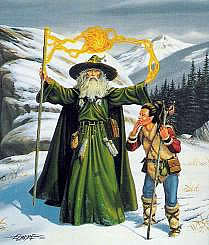Kender (fantasy)
| Kender | |
|---|---|

The kender Tasslehoff Burrfoot, on the right. Image created by Larry Elmore, for the cover "The War of the Lance"
|
|
| Characteristics | |
| Type | Humanoid |
| Publication history | |
| First appearance | "A Stone's Throw Away" by Roger E. Moore, Dragon magazine #85 (May 1984) |
| Based on | Halfling |
Kender are a type of fantasy race first developed for the Dragonlance campaign setting for the Dungeons & Dragons fantasy role playing game published by TSR, Inc. in 1984. The first kender character was created by Harold Johnson as a player character in a series of role-playing adventures co-authored by Tracy Hickman and Margaret Weis. Weis and Hickman's Dragonlance shared world novels did much to popularize the kender among readers and players alike, largely through the character Tasslehoff Burrfoot, who became one of the main protagonists in the series.
Tasslehoff first appeared in the Dragonlance adventure module DL1 Dragons of Despair, published in March 1984. The kender are described in a review of the module: "wizened 14-year-olds and, unlike halflings, they wear shoes." The first novel publication featuring a kender was in the book Dragons of Autumn Twilight, published in November 1984.
In preparation for the Dragonlance setting, Tracy Hickman ran a series of Dungeons & Dragons adventures. Harold Johnson, one of those involved in the games, chose to play a halfling thief character whom he called Almar Tann. When Hickman, Johnson and others moved to the Dragonlance setting for their games, the character of Almar Tann went with them. It soon became clear to those involved, however, that halflings were unsuitable to the Dragonlance world. As Johnson described it, this was especially due to his character's possession of a ring of invisibility, so that "it all sounded too much like another story," referring to Bilbo Baggins and the One Ring. Halflings were then dropped from the campaign, and Johnson developed both the initial concept of the kender and the first representative of the fantasy race, Tasslehoff Burrfoot. To solidify the distinction, they were originally described as "thinner, more wiry, and more cunning and streetwise" than halflings.
...
Wikipedia
